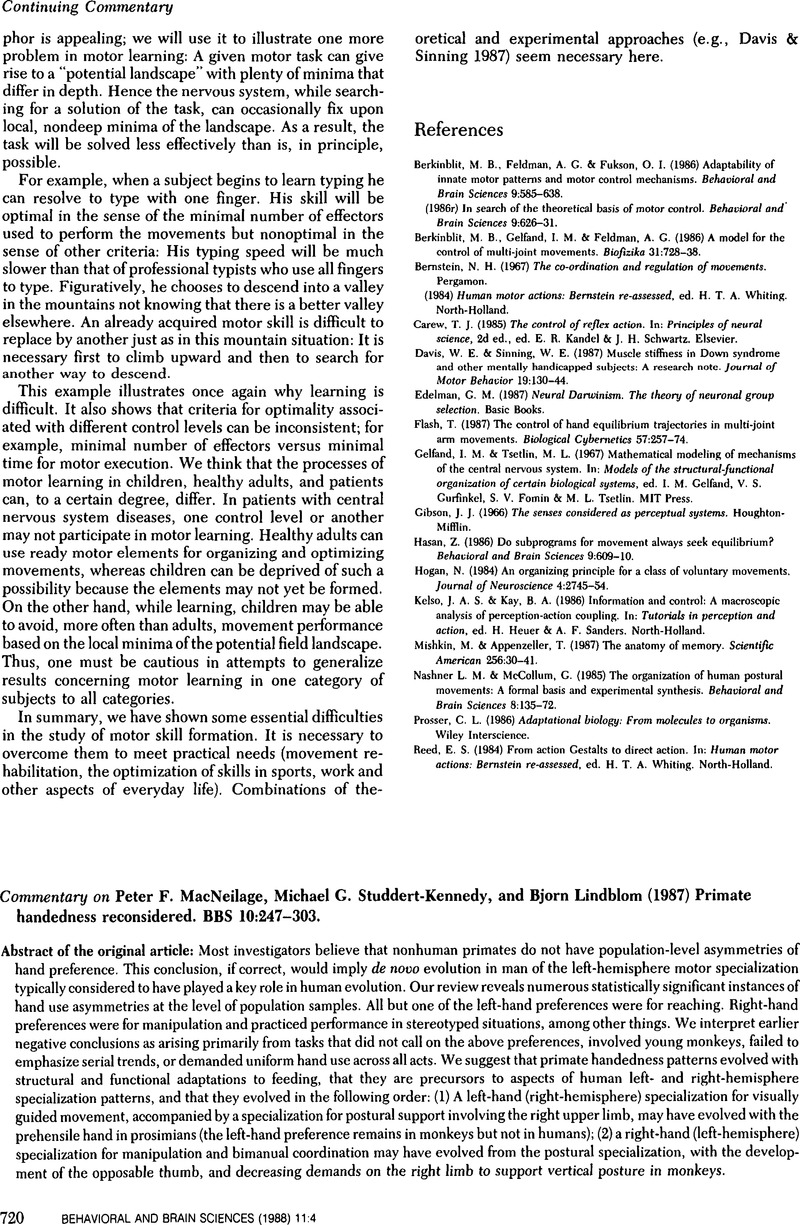No CrossRef data available.
Article contents
Giving the primates a hand: Is the applause really justified?
Published online by Cambridge University Press: 04 February 2010
Abstract
An abstract is not available for this content so a preview has been provided. Please use the Get access link above for information on how to access this content.

- Type
- Continuing Commentary
- Information
- Copyright
- Copyright © Cambridge University Press 1988
References
Beck, C. M. H. & Barton, R. L. (1972) Deviation and laterally of hand preference in monkeys. Cortex 8:339–63.CrossRefGoogle ScholarPubMed
Boesch, C. & Boeseh, H. (1981) Sex differences in the use of natural hammers by wild chimpanzees: A preliminary report. Journal of Human Evolution 10:585–93.CrossRefGoogle Scholar
Brésard, B. & Bresson, F. (1987) Reaching or manipulation. Behavioral and Brain Sciences 10:265–66.CrossRefGoogle Scholar
Chapman, J. P., Chapman, J. J. & Allen, J. J. (1987) The measurement of foot preference. Neuropsychologia 25:579–84.CrossRefGoogle ScholarPubMed
Cicchetti, D. V. (1987). On viewing the evidence for primate handedness: Some biostatistical considerations. Behavioral and Brain Sciences 10:268–69.CrossRefGoogle Scholar
Denenberg, V. H. & Yutzey, D. A. (1985) Hemispheric laterality, behavioral asymmetry, and the effects of early experience in rats. In: Cerebral lateralization in nonhuman species, ed. Glick, S. D.. Academic Press.Google Scholar
Dhall, U. & Singh, I. (1977) Anatomical evidence of one-sided forelimb dominance in the rhesus monkey. Anatomischer Anzeiger 141:420–25.Google ScholarPubMed
Fagot, J. & Vauclair, J. (1988a) Handedness and manual specialization in the baboon. Neuropsychologia 26.CrossRefGoogle Scholar
Fagot, J. & Vauclair, J. (1988b) Handedness and bimanual coordination in the lowland gorilla. Brain Behavior and Evolution 29.CrossRefGoogle Scholar
Falk, D., Pyne, L., Helmkamp, C. & De Rousseau, C. (1988) Skeletal asymmetry in forelimb of Macaca mulatta. American Journal of Physical Anthropology 70.Google Scholar
Glick, S. D., Ross, D. A. & Hough, L. B. (1982) Lateral asymmetry of neurotransmitters in the human brain. Brain Research 234:53–63.CrossRefGoogle Scholar
Glick, S. D. & Shapiro, R. M. (1985) Functional and neurochemical mechanisms of cerebral lateralization in rats. In: Cerebral lateralization in nonhuman species, ed. Glick, S. D.. Academic Press.Google Scholar
Healey, J. M., Liederman, J. & Geschwind, N. (1986) Handedness is not a unidimensional trait. Cortex 22:33–53.CrossRefGoogle Scholar
Heilman, K. M., Coyle, J. M., Gonyea, E. F. & Geschwind, N. (1973) Apraxia and agraphia in a left-hander. Brain 96:21–28.CrossRefGoogle Scholar
Hopkins, W. D. & Morris, R. D. (1988) Laterality for visual-processing in two language-trained chimpanzees. Behavioral Neuroscience 102.Google Scholar
Hopkins, W. D., Washburn, D. A. & Rumbaugh, D. M. (1988) A note on hand use in the manipulation of joysticks by two rhesus monkeys (Macaca mulatta) and three chimpanzees (Pan. troglodytes). Journal of Comparative Psychology 102.Google Scholar
King, J. E. & Landau, V. (in preparation) Manual preferences in varieties of reaching in squirrel monkeys. In: New evidence of primate behavioral asymmetries, ed. Ward, J..Google Scholar
Kooistra, C. A. & Heilman, K. M. (1988) Motor dominance and lateral asymmetry of the globus pallidus. Neurology 38:388–90.CrossRefGoogle ScholarPubMed
Krmpotic, J. (1959) Donees anatomiques et histologiques relatives aux effecteurs laryngo-pharyngo-buccaux. Revue de Laryngologie (Bordeaux) 11:829–48.Google Scholar
Larsen, C. S. (1985) Dental modifications and tool use in the Western Great Basin. American Journal of Physical Anthropology 67:393–402.CrossRefGoogle ScholarPubMed
MacNeilage, P. F. (1987) The evolution of hemispheric specialization for manual function and language. In: Higher brain functions: Recent explorations of the brain's emergent properties, ed. Wise, S.. Wiley.Google Scholar
MacNeilage, P. F. (in preparation) The “Postural Origins” theory of primate neurobiological asymmetries. In: Biobehavioral foundations of language development, ed. Krasnegor, N..Google Scholar
McKain, K. S., Studdert-Kennedy, M. G., Spieker, S. & Stern, D. (1983) Infant intermodal speech perception is a left hemisphere function. Science 219:1347–49.CrossRefGoogle Scholar
Peters, M. (1988) Footedness: Asymmetries in foot performance and skill and neuropsychological assessment of foot movement. Psychological Bulletin 103:179–92.CrossRefGoogle Scholar
Post, D. G., G., Hausfater & McCuskey, S. A. (1980) Feeding behavior of yellow baboons (Papio cynocephalus): Relationship to age, gender, and dominance rank. Folia Primatologia 34:170–95.CrossRefGoogle ScholarPubMed
Searleman, A. (1980) Subject variables and cerebral organization for language. Cortex 16:239–54.CrossRefGoogle ScholarPubMed
Robinson, T. E., Becker, J. B., Camp, D. M. & Mansour, A. (1985) Variation in the pattern of behavioral and brain asymmetries due to sex differences. In: Cerebral lateralization in nonhuman species, ed. Click, S. D.. Wiley.Google Scholar
Trevarthen, C. (1978) Manipulative strategies of baboons and the origins of cerebral asymmetries. In: Asymmetrical function of the brain, ed. Kinsbourne, M. Cambridge University Press.Google Scholar


